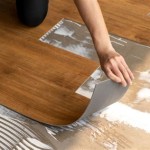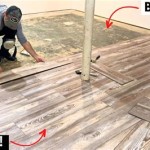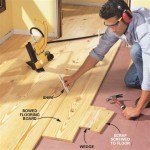Tongue and Groove Porch Flooring Repair: A Comprehensive Guide
Tongue and groove (T&G) porch flooring offers a classic aesthetic and durable surface for outdoor living spaces. Its interlocking design creates a tight seal, minimizing gaps and preventing water penetration. However, exposure to the elements inevitably leads to wear and tear, necessitating repair or replacement over time. This article provides a comprehensive overview of common issues affecting T&G porch flooring, methods for diagnosing the extent of the damage, and detailed instructions for effective repair strategies.
Understanding the construction of T&G flooring is crucial for effective repair. Each board features a "tongue" on one edge and a corresponding "groove" on the opposite edge. This configuration allows for a seamless connection between boards, creating a strong and relatively waterproof surface. When properly installed and maintained, T&G flooring provides a long-lasting and visually appealing porch. However, factors such as moisture, impact damage, and improper installation can compromise its integrity.
Identifying Common Problems in Tongue and Groove Porch Flooring
Several issues can plague T&G porch flooring, each requiring a specific approach to repair. Identifying the problem accurately is the first step in formulating a successful repair strategy. Common issues include:
*Rot and Decay:
This is perhaps the most prevalent problem, particularly in areas with high humidity or where the floor is exposed to standing water. Rot is typically caused by fungal growth that breaks down the wood fibers, leading to structural weakening and eventual collapse. Signs of rot include discoloration, softening of the wood, and a musty odor. *Splintering and Cracking:
Surface damage from the elements and foot traffic can lead to splintering and cracking. While often cosmetic, these imperfections can worsen over time if not addressed, potentially leading to more significant structural issues. *Loose Boards:
Over time, the fasteners holding the boards in place can loosen or corrode, causing the boards to become unstable and potentially create tripping hazards. This issue can arise from improper installation, inadequate fasteners, or excessive moisture exposure. *Water Damage and Staining:
Water infiltration can cause staining, warping, and delamination of the wood. These issues are often related to inadequate sealing or drainage problems around the porch. *Insect Infestation:
Termites, carpenter ants, and other wood-boring insects can cause significant damage to T&G flooring. Signs of infestation include small holes in the wood, sawdust-like material (frass), and weakened structural integrity.Careful inspection is essential for identifying the extent and nature of the damage. This involves examining the boards for signs of rot, cracks, loose fasteners, and any other visible defects. Probing the wood with a screwdriver or awl can help determine the extent of rot or decay. A thorough inspection can save time and resources by guiding the repair process.
Preparing for Tongue and Groove Porch Flooring Repair
Before commencing any repair work, proper preparation is paramount. This includes gathering the necessary tools and materials, as well as taking steps to ensure the safety of the work environment. Key steps in preparing for T&G porch flooring repair include:
*Safety Precautions:
Wear appropriate personal protective equipment (PPE), including safety glasses, gloves, and a dust mask. This will protect against splinters, dust, and potential exposure to harmful chemicals. *Tool Acquisition:
Essential tools for T&G porch flooring repair include a pry bar, hammer, screwdriver, chisel, measuring tape, saw (circular saw or handsaw), drill, sandpaper, and potentially a router for more complex repairs. *Material Procurement:
Acquire the necessary replacement boards, fasteners (screws or nails suitable for exterior use), wood preservative, wood filler, paint or stain, and any other materials specific to the repair task. *Area Preparation:
Clear the porch of all furniture, planters, and other obstructions. Sweep the area thoroughly to remove dirt and debris. This ensures a clean and safe working environment. *Assess Substructure:
Inspect the supporting joists and framing beneath the porch floor. Any damage to these components must be addressed before repairing the T&G flooring. Rot or decay in the substructure will compromise the integrity of the entire porch.Proper preparation not only ensures a more efficient repair process but also contributes to the longevity and durability of the finished product.
Step-by-Step Guide to Repairing Tongue and Groove Porch Flooring
The specific steps involved in repairing T&G porch flooring will depend on the nature and extent of the damage. Here are some common repair scenarios and detailed instructions for addressing them:
*Replacing a Damaged Board:
1.Remove the Damaged Board:
Use a pry bar to gently lift the damaged board, starting at one end. If the board is nailed or screwed in place, use a nail puller or screwdriver to remove the fasteners first. If the tongue is locked in place, consider using a chisel and hammer to carefully break off the tongue along the length of the board. 2.Prepare the Replacement Board:
Measure and cut the replacement board to the exact length of the removed board. Use a router or saw to create a tongue and groove on the replacement board that matches the existing flooring, if necessary. 3.Apply Wood Preservative:
Treat the exposed edges and underside of the replacement board with a wood preservative to protect against rot and insect infestation. Allow the preservative to dry completely before proceeding. 4.Install the Replacement Board:
Carefully align the tongue and groove of the replacement board with the adjacent boards and gently tap it into place using a hammer and a wood block to avoid damaging the surface. 5.Secure the Board:
Secure the replacement board to the underlying joists using screws or nails. Space the fasteners evenly along the length of the board, ensuring they are countersunk to prevent tripping hazards. 6.Fill Gaps:
Use wood filler to fill any gaps or imperfections around the edges of the replacement board. Allow the filler to dry completely and then sand it smooth. 7.Finish the Board:
Apply paint or stain to the replacement board to match the existing flooring. Apply multiple coats as needed to achieve a uniform finish. *Repairing Splintered or Cracked Boards:
1.Clean the Area:
Remove any loose splinters or debris from the damaged area. 2.Apply Wood Filler:
Fill the cracks or splintered areas with wood filler. Use a putty knife to apply the filler evenly and smooth the surface. 3.Allow to Dry and Sand:
Allow the filler to dry completely according to the manufacturer's instructions. Sand the filled area smooth with fine-grit sandpaper, blending it seamlessly with the surrounding surface. 4.Apply Finish:
Apply paint or stain to the repaired area to match the existing flooring. Apply multiple coats as needed to achieve a uniform finish. *Securing Loose Boards:
1.Identify the Cause:
Determine why the board is loose. It could be due to loose fasteners, rotted wood, or a damaged substructure. 2.Replace or Tighten Fasteners:
If the fasteners are loose, try tightening them. If they are corroded or damaged, replace them with new screws or nails suitable for exterior use. 3.Repair Rotted Wood:
If the wood around the fasteners is rotted, carefully remove the rotted wood and fill the void with wood filler or epoxy. Allow the filler to dry completely before re-installing the fasteners. 4.Address Substructure Issues:
If the substructure is damaged, it must be repaired before securing the loose boards. This may involve replacing rotted joists or adding additional support.These are just a few of the common repair scenarios encountered with T&G porch flooring. The specific approach will always depend on the unique circumstances of the project. Always prioritize safety and quality workmanship to ensure a durable and aesthetically pleasing result.
Preventative Maintenance for Tongue and Groove Porch Flooring
Preventative maintenance is crucial for extending the lifespan of T&G porch flooring and minimizing the need for costly repairs. Regular maintenance practices can significantly reduce the risk of rot, decay, and other common problems. Key preventative measures include:
*Regular Cleaning:
Sweep the porch regularly to remove dirt, leaves, and other debris that can trap moisture. Periodically wash the porch with a mild soap and water solution, avoiding harsh chemicals that can damage the wood. *Annual Inspection:
Conduct an annual inspection of the porch flooring to identify any signs of damage or deterioration. Look for cracks, splinters, loose boards, and signs of rot or insect infestation. *Sealing and Staining:
Apply a high-quality sealant or stain to the porch flooring every one to two years to protect against moisture and UV damage. Choose a product specifically designed for exterior use and follow the manufacturer's instructions carefully. *Proper Drainage:
Ensure that the porch has adequate drainage to prevent water from pooling on the surface. Check for clogged gutters or downspouts and address any drainage issues promptly. *Prompt Repairs:
Address any minor repairs promptly to prevent them from escalating into more significant problems. Repairing a small crack or replacing a loose fastener is far less costly and time-consuming than replacing an entire section of flooring.By implementing these preventative maintenance practices, homeowners can significantly extend the life of their T&G porch flooring and maintain its beauty and functionality for years to come.

Fixing A Rotten Tongue And Groove Porch Floor The Craftsman Blog

Fixing A Rotten Tongue And Groove Porch Floor The Craftsman Blog

Fixing A Rotten Tongue And Groove Porch Floor The Craftsman Blog

Fixing A Rotten Tongue And Groove Porch Floor The Craftsman Blog

Fixing A Rotten Tongue And Groove Porch Floor The Craftsman Blog

Repairing Tongue Groove Porch Flooring

Repair For An Old Wooden Porch Extreme How To

How To Replace A Rotten Wood Porch Floor Today S Homeowner

How To Repair A Tongue And Groove Deck

Is It Ok To Leave The Rough Edge Of Tongue Groove Composite Visible
Related Posts








